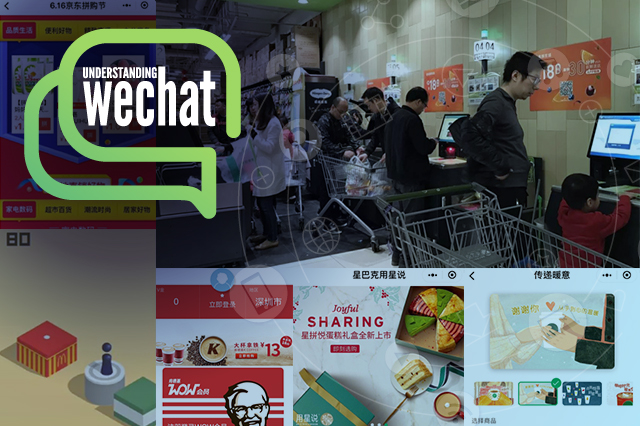
albert Chan
Introduction
Since launch in early 2017, WeChat mini programs have grown quickly. As of June 2018, there were about 260 million daily active mini program users, according to Aldzs.com, a WeChat mini programs analytics firm. And the number of mini programs reached one million, according to WeChat parent company Tencent. The apps are designed to use little phone space, just 10 megabytes, and run WeChat so do not require a separate download but offer much of the same functionality. In this report, we will look at WeChat mini programs and how brands and retailers are using them to reach customers. For more information on WeChat, visit our prior reports Understanding WeChat, China’s Super App: Part 1—The Definite Leader in China and WeChat Mini Programs: Opening Up New Pathways for Selling.WeChat Mini Programs Users
According to figures from mini program research company Aldzs.com, this is what WeChat mini programs users looked like in the first half of 2018:- Male and female users were evenly distributed, at 47% and 53% respectively.
- Mini programs are for the young: 78% of users were aged 18–39.
- Users were evenly spread across different city tiers, with tier 1 users representing 16% of the total.
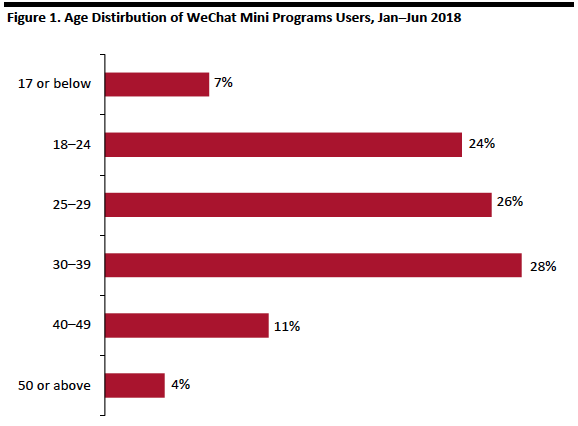 Source: Aldzs.com/Coresight Research[/caption]
[caption id="attachment_61946" align="aligncenter" width="574"]
Source: Aldzs.com/Coresight Research[/caption]
[caption id="attachment_61946" align="aligncenter" width="574"]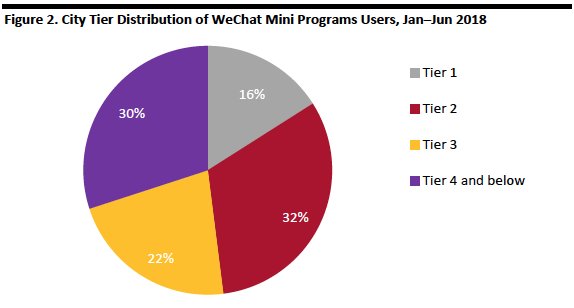 Source: Aldzs.com/Coresight Research[/caption]
Source: Aldzs.com/Coresight Research[/caption]
Gaming, Retail and Tools Are Popular Categories
Gaming mini programs, also known as mini games, came onto the WeChat scene in late 2017, but have quickly become one of the most popular categories. According to Aldzs.com’s top mini programs ranking (based on the number of times each mini program was searched for, used and shared in WeChat, mini games replaced retail and tool mini programs to become the most popular category, representing 37% of the top 100 as of June 2018. [caption id="attachment_61947" align="aligncenter" width="576"]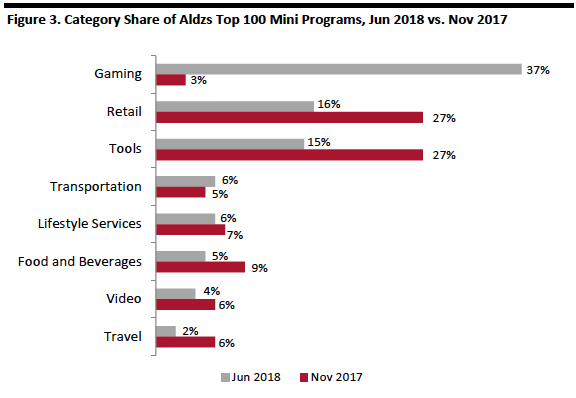 Source: Aldzs.com/Coresight Research[/caption]
Gaming
Tiao Yi Tiao was a successful jumping game which quickly accumulated 100 million daily active users, according to WeChat. The huge user base even attracted advertisers: McDonalds and Nike each paid over $700,000 to have their logos appear in the game, according to news website Jing Daily.
[caption id="attachment_61948" align="aligncenter" width="252"]
Source: Aldzs.com/Coresight Research[/caption]
Gaming
Tiao Yi Tiao was a successful jumping game which quickly accumulated 100 million daily active users, according to WeChat. The huge user base even attracted advertisers: McDonalds and Nike each paid over $700,000 to have their logos appear in the game, according to news website Jing Daily.
[caption id="attachment_61948" align="aligncenter" width="252"] McDonalds’ logo featured in mini game Tiao Yi Tiao
McDonalds’ logo featured in mini game Tiao Yi TiaoSource: CNET.com[/caption] Tiao Yi Tiao was more than just a stand-alone game: As part of WeChat, it also has a number of social networking features. For example, users can see how their score compares to friends’ scores, which drives engagement as players seek to beat one another’s scores. The game is also easy to play, so has attracted non-regular game players too. At the WeChat Conference 2018, the company said Tiao Yi Tiao players were 50% female, 41% casual gamers and 22% non-gamers. The success of Tiao Yi Tiao led WeChat to create a number of other leisure-focused, easy-to-play mini games. WeChat helped promote the game further by placing a button for the game on the drop-down menu at the top of the “Chats” page — the first page users see when they open WeChat. To access Tiao Yi Tiao, users simply need scroll down from the top of the “Chats” page. Users can also save mini programs into “My Mini Programs” to save their most-used in one place. [caption id="attachment_61949" align="aligncenter" width="388"]
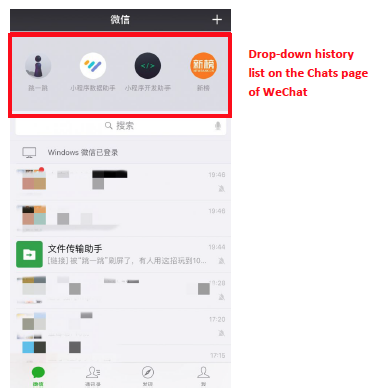 Source: Hibwc.com/Coresight Research[/caption]
Retail: In-Store Purchase
Yonghui superstore, a supermarket chain partly owned by Tencent and headquartered in the southern province of Fujian, developed a WeChat mini program that lets customers shop by scanning product QR codes and paying directly with WeChat Pay. Shoppers can even request home delivery to avoid waiting in line.
[caption id="attachment_61950" align="aligncenter" width="562"]
Source: Hibwc.com/Coresight Research[/caption]
Retail: In-Store Purchase
Yonghui superstore, a supermarket chain partly owned by Tencent and headquartered in the southern province of Fujian, developed a WeChat mini program that lets customers shop by scanning product QR codes and paying directly with WeChat Pay. Shoppers can even request home delivery to avoid waiting in line.
[caption id="attachment_61950" align="aligncenter" width="562"] Self-checkouts at a Yonghui supermarket
Self-checkouts at a Yonghui supermarketSource: MP.163.com[/caption]
Retail: Location-Based Store Locator
WeChat’s location feature means mini program offerings can be customized based on what’s nearby. Users simply tap the “Mini Programs Nearby” function, and the app will show mini programs for merchants near the user’s location. Some brands also launched store-locator functionality in their mini programs to make it easier for customers to find the nearest location. The store-locator feature in Burberry’s mini program lets users make an appointment at the closest store (or whichever store they choose).
[caption id="attachment_61951" align="aligncenter" width="386"]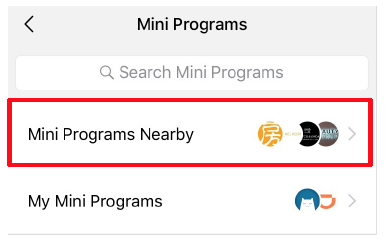 Mini Programs Nearby function sits under the Mini Programs page
Mini Programs Nearby function sits under the Mini Programs pageSource: Coresight Research[/caption] [caption id="attachment_61952" align="aligncenter" width="574"]
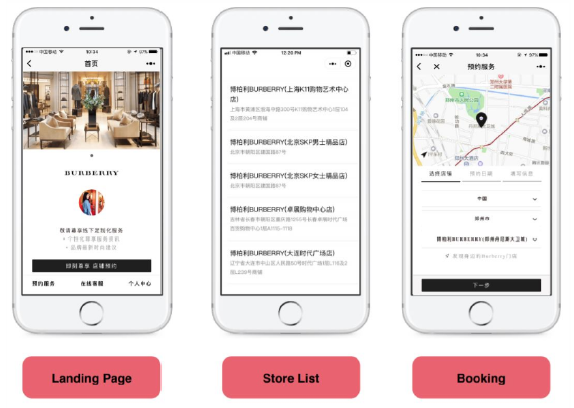 Burberry’s store-locator function in its mini program
Burberry’s store-locator function in its mini programSource: Jing Daily[/caption] Retail: Personalization Consumers increasingly demand personalized offerings, and WeChat mini programs let users design their own products. Luxury brand Sergio Rossi launched a mini program to allow users to create the shoe they want by adjusting the color, materials and adding text engraving. Users can preview the designs before ordering. [caption id="attachment_61953" align="aligncenter" width="274"]
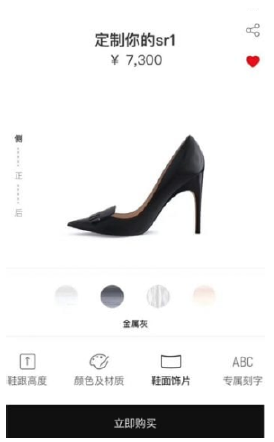 Customization function in Sergio Rossi’s mini program
Customization function in Sergio Rossi’s mini programSource: Jing Daily[/caption] Tools Mini programs are just that: Mini. For all they can do, they are more limited in functionality than a stand-alone native app. That said, some companies are creating mini programs that have all the functionality of a stand-alone app. Mobike is a bike-sharing company in China and was among the first to launch a WeChat mini program. Its mini program does everything its native app does, including locating bikes and topping up user accounts. Even the user interface looks similar on WeChat, so users will see a familiar look and feel on both. [caption id="attachment_61954" align="aligncenter" width="260"]
 Bike-locating interface of Mobike mini program
Bike-locating interface of Mobike mini programSource: Nextstephub.com[/caption] Another popular mini program is one used to get information on bus arrivals. [caption id="attachment_61956" align="aligncenter" width="252"]
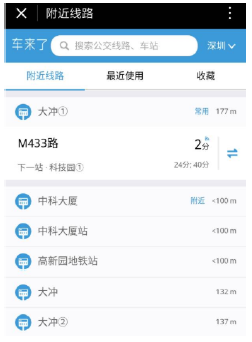 Bus time checker mini program interface
Bus time checker mini program interfaceSource: Developers.Weixin.QQ.com[/caption]
Mini Programs Add Extra Capabilities to WeChat Official Accounts
Brands have long relied on WeChat official accounts, akin to an official Facebook page, to keep in touch with Chinese customers. However, WeChat official accounts are not dynamic and rely on push notifications to interact with account followers. But by incorporating mini programs into their WeChat official accounts, brands have more power, and can offer customers more functions. Take fast-food chain KFC. The company’s WeChat official account is the main hub for customers to access five mini programs, each of which carries out a specific function: one is a digital membership card, one an in-store ordering tool, another manages redemptions – there’s even a group buying and delivery program. These five mini programs effectively turned KFC’s WeChat official account into a full-fledged, one-stop platform. This is what the KFC mini programs do:- A membership card mini program means customers don’t need to carry a physical membership card, as it is already digitally loaded on the mini program.
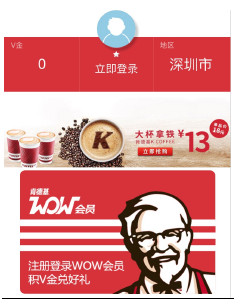 Membership card is digitally loaded on the mini program
Membership card is digitally loaded on the mini programSource: Coresight Research[/caption]
- The in-store ordering mini program allows users to view the menu and pay directly with WeChat without going to the cashier.
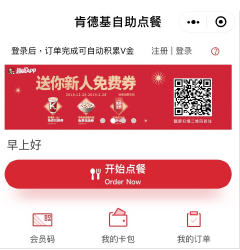 KFC’s in-store ordering mini program
KFC’s in-store ordering mini programSource: Coresight Research[/caption]
- The redemption mini program lets users redeem points for free KFC meals with loyalty points - or even products such as cosmetics, household wares, electrical appliances, apparel and bags by combining points with cash.
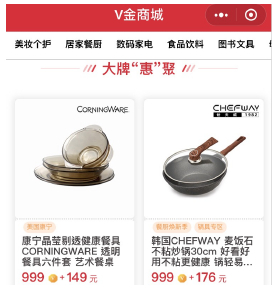 Users can buy kitchen wares at lower prices, combined with loyalty points
Users can buy kitchen wares at lower prices, combined with loyalty pointsSource: Coresight Research[/caption]
- A group-buying mini program lets users buy KFC meals together as a group at better prices.
 Discounts offered upon group purhcase of three people
Discounts offered upon group purhcase of three peopleSource: Coresight Research[/caption]
- The delivery service mini program allows users to order KFC meals and have them delivered, either right away or at some point in the future.
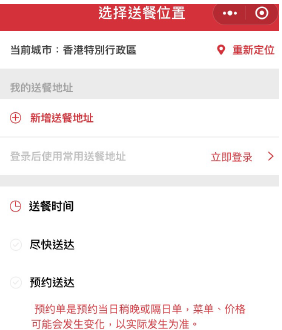 KFC’s delivery service mini program
KFC’s delivery service mini programSource: Coresight Research[/caption]
Mini Programs Boost Social Commerce
According to digital services company Tolmao Group, the cost of developing a WeChat mini program is 20% less than developing a stand-alone native app, and also avoids the need to develop one for Apple iOS and another for Android systems. But saving 20% on development costs is not what attracts international brands: it’s the ability to easily reach over 1 billion active users immediately in an app they are familiar with and which offers social network features a native app never could.
Here’s what some international brands are doing.
Starbucks
Starbucks has one of the most successful apps in the U.S., racking up more in-app sales and payments than any other digital payment system aside from market dominators such as Visa and PayPal. But in China, the company went for a WeChat mini program, which focuses on gifting. Users can purchase and send gift cards to friends on WeChat, which in turn drives store traffic as recipients use the cards.
[caption id="attachment_61965" align="aligncenter" width="572"]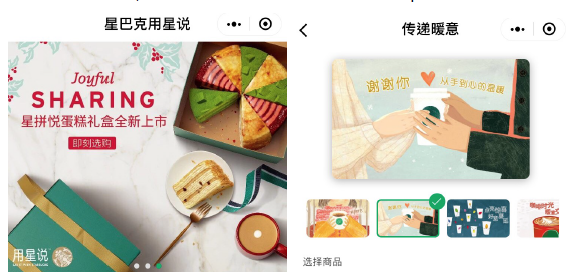 Starbucks’s mini program
Starbucks’s mini programSource: Coresight Research[/caption] JD.com China’s second-largest e-commerce player JD.com has set up a unique e-commerce venue on its mini program. Its mini program has a group buying feature which is not available in its native app. During last year’s 618 Shopping Festival, JD.com’s annual online shopping festival to celebrate its founding anniversary on June 18, the company’s mini program recorded a 66% increase in sales orders year-over-year, according to Aldzs.com. [caption id="attachment_61966" align="aligncenter" width="238"]
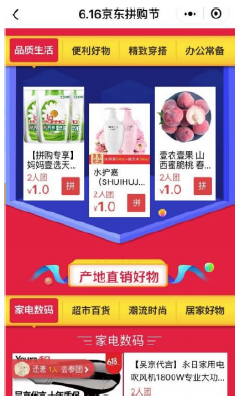 June 16 JD Group Buying Day on JD.com’s mini program
June 16 JD Group Buying Day on JD.com’s mini programSource: Aldzs.com[/caption]